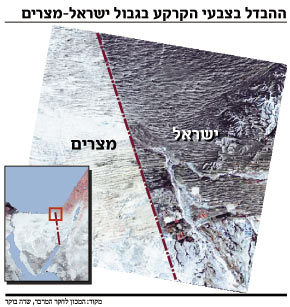Environment / The ground on the Israeli side of the border is darker, because goats do not step on the fire areas
By: Rinat Zafir

Egypt and Israel are separated by a thin border line. The border - whose two sides speak - is an artificial border established by a political agreement. However, when viewed from above it can be thought that this is a natural border between two completely different land areas. Satellite images of the area show a clear difference in the color of the soil on both sides of the border - the soil on the Israeli side looks much darker than the Egyptian side. The dividing line between dark and light exactly coincides with the long border line.
According to a study conducted at the Desert Research Institute in Sde Boker, the dramatic differences between the two sides of the border stem from the difference in the nature of human activity in the area: while on the Egyptian side there are processes that increase desertification, the nature of land use on the Israeli side limits it.
Dr. Arnon Karniali, head of the Remote Sensing Laboratory at the Desert Research Institute, analyzed the satellite images of the border area. The analysis of the photos - the first of which were taken already in the XNUMXs - made it possible to follow the changes in the color of the soil over a long period of time, during which there were also political changes in the region.
The difference between the shades is evident not only in sandy areas - such as those in the western part of the border - but also in rocky areas. At ground level it is difficult to recognize the difference in colors between the two sides of the border, but they are clearly visible in the satellite images.
The distinct color contrast between the two areas is already evident in the satellite images, which were taken even before the Six Day War and the occupation of Sinai. It became blurred after the war, when the movement of Bedouin tribes from both sides of the border became possible - which, according to Karanieli, are the main cause of the changes to the land. The contrast is revealed again in the photos taken after Sinai was returned to Egypt, 20 years ago.
According to Karneali, the main reason for the difference in the color of the soil on both sides of the border is the development of biological membranes on the surface of the soil on the Israeli side, and on the other hand, the prevention of their development on the Egyptian side.
The crusts developed on the Israeli side without hindrance, because after the return of Sinai, most of the area became an area of fire areas and nature reserves, and Bedouin grazing in the area stopped almost completely. On the other hand, on the Egyptian side, the ground was trampled by the herds of the Bedouin tribes that move freely in the area, so the development of the crusts was not possible.
The crusts that developed on the Israeli side of the border contain, among other things, clay grains, silt (deposits of sand and soil) and organic materials, and are what give them a darker shade than the color of bare sand. The ecological importance of these materials is that they trap the soil grains and protect the surface from drifting processes. They also maintain water reservoirs, as they reduce the evaporation of water that has infiltrated the upper layers of the soil.
On the Egyptian side, on the other hand, the area remains exposed and has a constant movement of sand. The fact that the bushes and trees that trap the sands are used for heating and various domestic uses also contributes to this process.
This created a situation where on the Israeli side there is a richer and more diverse ecosystem - which is less desert - while on the Egyptian side the variety of species is smaller. In the long term, the ecological poverty makes it difficult to utilize the area for human needs.
According to Karneali, the way to deal with the phenomena on the Egyptian side is to regulate the activity of the herds in the area. This will allow the development of membranes on the surface of the ground, while gradually slowing down desertification.
The attitude towards the role of the Bedouin herds in Israel varies from region to region. Ecologists say that in the northern Negev, the uncontrolled activity of the herds has caused the destruction of the area and damage to the vegetation. On the other hand, in the areas from which all the herds were removed - such as the Judean, Carmel and Galilee mountains - a forest developed that was prone to fires, so they decided to return the herds to them in a controlled manner.

One response
Not everything that occurs naturally, is clear and understandable, from personal experience, on the border between southern Arizona and Mexico, which is also an invisible line border, the flies and mosquitoes of Mexico do not move to Arizona and there is no sense in this. But that's the situation, and you can actually see how the insects reach the border and don't cross, it's quite amazing.